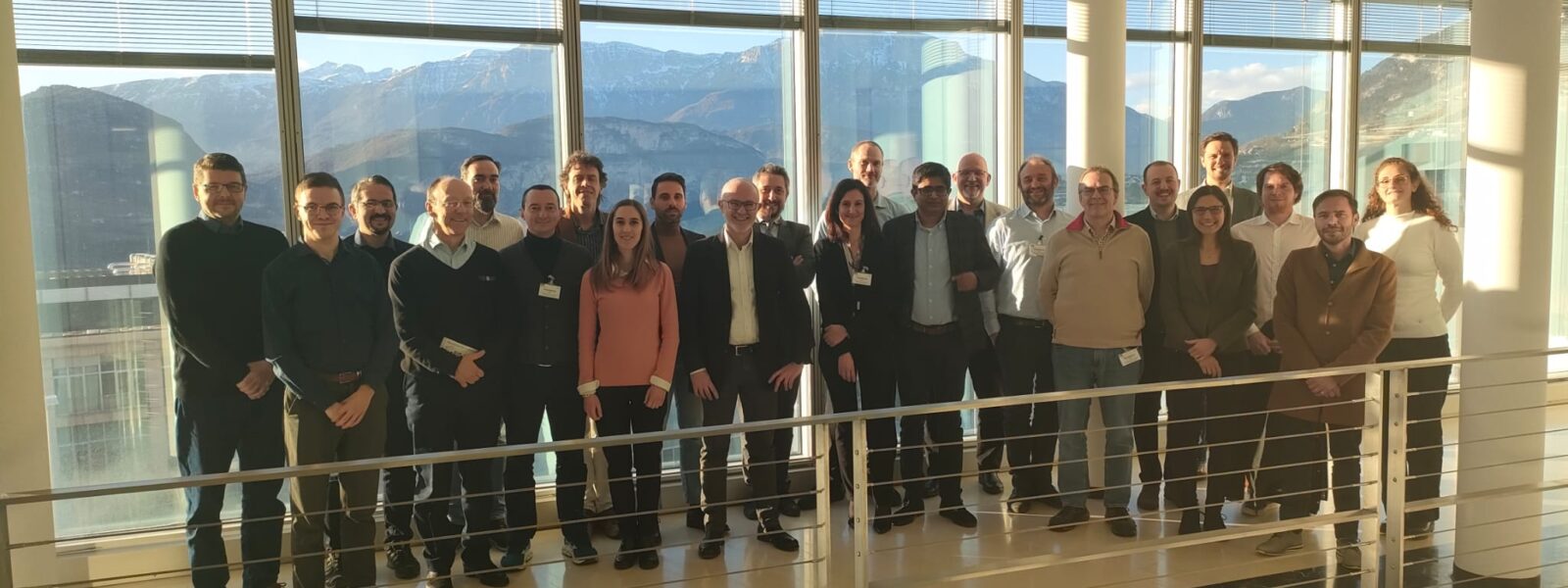Direct use of ammonia in fuel cells

AMON project to pave the way for a new breakthrough technology in Europe
The kick-off meeting of the project AMON “Development of a next generation AMmONia FC system” was held on 31 January 2023 in Trento, hosted by Fondazione Bruno Kessler, and followed by a visit to the manufacturing site of Solid Oxide technology by SolydEra in Pergine. All Partners were present to launch the activities of this Horizon Europe project, which will last for 3 years and is funded from the Clean Hydrogen Partnership.
The overarching objective of AMON project is to develop a novel system for the utilization and conversion of ammonia into electric power at high efficiency using a solid oxide fuel cell system. The project will deal with the design of the basic components of the system including the fuel cell, an ammonia burner, ammonia resistant heat exchangers, the engineering of the whole Balance of Plants, and validation of the compliance with ammonia use for all the specific parts and components. Optionally, depending on system needs, an ammonia cracker and anode gas recirculation will be developed.
Fundamental for the project is the interdisciplinary consortium of 13 partners coordinated by Fondazione Bruno Kessler, through the Centre for Sustainable Energy. Renowned industrial leaders such as SolydEra (Italy), Alfa Laval Technologies AB (Sweden), Alfa Laval Aalborg AS (Denmark), Alfa Laval SPA (Italy) e SAPIO Produzione Idrogeno Ossigeno Srl (Italy), KIWA Nederland BV (The Netherlands) e KIWA Cermet (Italy) will collaborate with prominent research institutes such as Fondazione Bruno Kessler (Italy), Teknologian Tutkimuskeskus Vtt OY (Finlandia), Technical University of Denmark (Denmark), Ecole Polytechnique Fédérale De Lausanne (Switzerland), European Fuel Cell Forum AG (Switzerland) e Fachhochschule Zentralschweiz – Hochschule Luzern (Switzerland).
Why is ammonia important?
Ammonia production accounts for around 45% of current global hydrogen consumption, i.e. 33 million tonnes (Mt) of hydrogen in 2020, essentially fossil-derived. Replacing conventional ammonia with renewable ammonia produced from renewable hydrogen presents an early opportunity for action in decarbonising the chemical sector. As a transportable and storable energy carrier with high hydrogen energy content, it assists the H2 economy and can also promote new flexible stationary power generation.
What is the purpose of the project and what impact is targeted?
The goal is to demonstrate highly efficient, direct conversion of ammonia in fuel cells. Such a breakthrough would enable further major steps towards a sustainable energy economy. For instance, ammonia is also proposed as hydrogen carrier for long-range transport: new applications being explored include renewable ammonia as zero-carbon fuel in the maritime sector and for stationary power generation. Green ammonia is considered suitable for deep decarbonisation of the shipping sector, where it is a common commodity stored and transported in harbour environments with dedicated infrastructure and storage facilities. Furthermore, harbours are particularly exposed to strong load changes when ships dock or leave the ports. The use of fuel cell systems would be an opportunity to stabilise and support the port grid with localised power generation units. Running on a very likely future marine standard fuel, ammonia can be used to generate electricity without CO2 emissions. Ammonia can be produced from fully renewable sources at economically viable costs in various parts of the world, representing therefore an important vector to cover Europe’s energy import needs towards 2030. In REPowerEU it accounts for 20% of target final consumption of hydrogen at 2030 equivalent to 4 Mt of Hydrogen, mainly through import.
How to achieve the goals?
For the development of the solid oxide fuel cell, a G8X stack from SolydEra will be utilized, first validated in the laboratory at the level of single cells, for electrochemical properties, degradation, and post-operation analysis, at the level of single repeating units for the validation of interconnects and sealing components, and at the level of stacks and stack modules. An overall ammonia fuel cell system will be engineered and manufactured by Alfa Laval to be tested in a relevant environment in a port area (Venice) by SAPIO. The final system will be a 8 kWe, with a heat management system and a possible ammonia cracker. It will aim at an overall electrical efficiency of 70%.
“The Amon project will realize a breakthrough for the direct conversion of ammonia in Solid Oxide Fuel Cells” states Luigi Crema, Director of the Centre for Sustainable Energy of FBK, and AMON project coordinator. “Ammonia will become an important energy carrier for Europe, and as indicated in the Repower EU Report, it may constitute 40% of hydrogen imported in EU @2030. Ammonia will thus be important for the maritime and shipping sector, for autonomous power systems and remote datacentres, and for all applications where large amounts of energy need to be stored in small quantities. As Fondazione Bruno Kessler we are strongly motivated and glad to support AMON and drive the project to a successful impact”
Contacts of the Coordinator:
Luigi Crema
Centre for Sustainable Energy | FBK
The project is supported by the Clean Hydrogen Partnership and its members Hydrogen Europe and Hydrogen Europe Research.